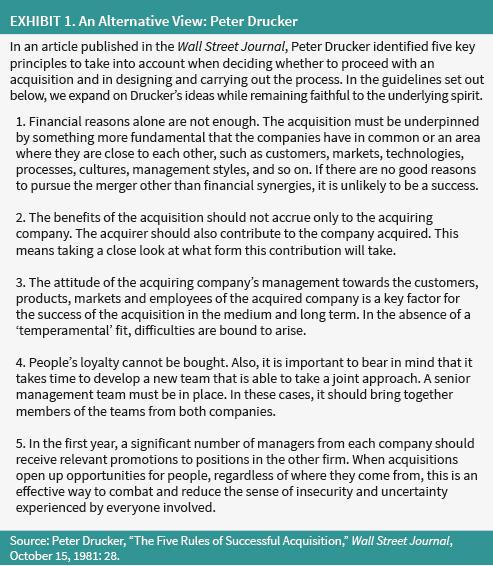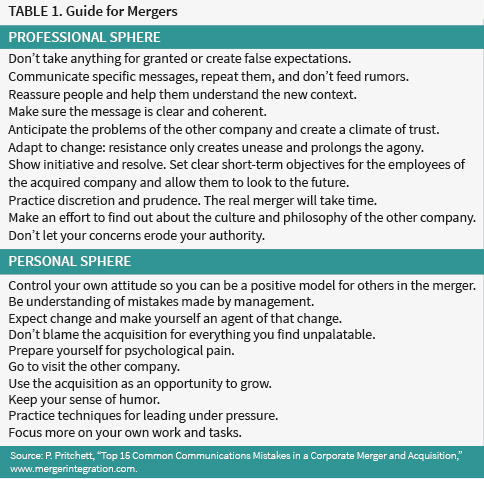By Guido Stein and Marta Cuadrado
In Part One, we addressed the key reasons why companies decide to pursue merger, the reasons why many of them fail, and the realities of mergers. In Part Two of this article, we will discuss human due diligence in Section 1. Section 2 will focus on the importance of merger and integration committees. Finally, in Section 3, we will offer a practical guide on how to professionally survive operations of this kind.
Acquisitions affect everyone involved to one degree or another. They are not neutral transactions in any sense: not from a financial, tax, legal, operational or commercial perspective, and especially not in terms of how they impact the people in both companies involved and other stakeholders (shareholders, suppliers, customers, etc.).
For many companies, mergers by acquisition have become a recurrent strategy for dealing with competition, gaining market share, or simply ensuring their survival. Their impact on stock markets is noted within hours, but their consequences for the people who live through them are rarely reflected in the media.
In tackling these issues, we will draw on the experience of managers who have gone through merger processes and ground our discussion in the scientific literature.
[ms-protect-content id=”9932″]
1. Real Due Diligence
According to executive participants in the IESE Business School’s general management programs, most merger processes focus almost exclusively on the financial aspects of the deal and ignore the factor at the heart of any business: the people involved. All the effort goes into collecting financial, operations-related and commercial information, and very little time is spent on what we might call “human due diligence”: analysis that focuses on the culture of the companies, the roles people play, and their skills, competencies, attitudes and values; in short, the elements that need to be handled with care to complete the merger without undue friction and without taking a needless toll on people.
Such an exercise, if carried out with skill, would put the acquiring company in a better position to decide who should stay in place and who should assume new responsibilities. Analyses of this kind, based on study of the business culture and organisational structure, are the best way to ensure that negotiations go smoothly and are less traumatic than is usually the case. But what factors need to be considered?
1.1. Managing the Process: Actions to Be Taken Before and During the Merger
A. Identify Key People
A map of talent within the organisation should be made. The focus should be on identifying both individuals who play a key role in the functioning of the organisation and those who stand out for their low productivity or absenteeism. The latter can be offered the chance to take advantage of a voluntary exit plan. This is an ideal way not to ‘inherit’ these employees at the end of the process.
B. Draw Out the Process of Implementing the Merger
The actual merger process should be drawn out so there is time to include integration actions, such as cross-company teams and mentoring, that encourage cultural interpenetration. Up until now the view has been that a merger has reached an endpoint when it ceases to generate new synergies, and this is the message that has been put across. Yet this is precisely when the integration of people and cultures really begins. However, this process is often decontextualised and disconnected from the merger process per se. The difficulty is so great, and the decision to merge so limited in scope, that one of the cultures generally ends up disappearing. The ‘winner’ remains, although disfigured by the process.
C. Design a Retention Plan
Companies undertaking mergers generally use retention plans with quantitative objectives, offer bonuses or long-term incentives, and review contracts and non-compete clauses. These measures are taken because companies know the best employees will soon receive offers from other firms. It is the responsibility of the human resources department to offer these valuable employees an attractive retention plan as soon as possible. Companies would rather invest their resources in retaining key people than prepare plans for replacing them, particularly given that it takes three to five years to develop the members of an operations team.1
2. The Merger or Integration Committee: Functions and Characteristics
As mentioned above, the lack of a committee that focuses specifically on the merger process is one of the reasons why mergers fail. Even when special committees are set up, their dissolution at the end of the technical part of the process often leaves people feeling abandoned. Managing this post-merger period requires people who are able to expeditiously push the organisation, deal with all levels of the hierarchy, mediate between the different groups involved, and perceive and bridge cultural gaps.2 Finding people with all these qualities is not easy, but the idea is not to look for a superhero. A number of companies that have gone through multiple mergers have developed specialised managers with the required skill set and integrated them in their organisations.
The main shortcoming of many mergers is a failure to define the role of the people involved in the process and specify how and to whom they should report.
2.1. Who Can Do This Kind of Work?
A. Knowledge of the Acquired Company
The leader of the merger committee must have a thorough understanding of the culture of the acquiring company in order to convey its cultural and organisational features to the employees joining the firm. He or she should be a point of reference for these employees and should therefore facilitate social connections between people from the two companies. People are often unsure about where the chair of the integration committee should come from: is it a good idea for someone from the acquired company to hold this position? The answer is usually no. The head of the integration committee needs to be a veteran who knows the ins and outs of the company and has held various positions at different levels and in different business units and geographical locations.
B. Ability to Deal With People at All Levels
There are two critical periods in a merger process. The first is from the announcement of the merger to the point when the process officially ends. The second is the first hundred days after this official endpoint. Those responsible for leading committees need to exercise their authority when they have to close deals or ensure that deadlines are met. Their work demands that they make effective use of their people skills and practice active listening, not only when dealing with employees whose jobs are affected by the changes underway, but also in their contacts with senior managers.
It is not easy to wield authority while at the same time genuinely engaging with people at different levels of the organisation. Each situation requires a specific leadership style. This kind of flexibility may be an innate skill up to a point, but it is one that can also be acquired. There is a risk that the person appointed as committee leader will want to play the role of big boss, but the real goal is something quite different: to act as a mediator in order to achieve integration.
C. Feeling Comfortable With Disorder and Uncertainty
The people who lead these committees need to be able to manage many different teams from different areas and countries and get them to follow a structured plan, with clear communication mechanisms and simple processes. Leaders should possess a certain ‘mettle’ for two reasons: 1) the people working on the processes underway are disoriented. They are unsure to whom they should report or whether they will have a place of arrival when the merger is complete. It is therefore important that the people in charge know how to motivate them and involve them in the process. This means encouraging them to participate in the new organisation and generating enthusiasm about the new project. 2) Integrating two companies is an appealing project. It involves a process akin to tearing them apart and then putting them back together from the ground up. But while this is going on, the businesses cannot actually stop working. In merger processes, those at the helm must constantly adapt and rethink their plans to keep pace with unfolding events.
D. Responsible Independence
Leading an integration process requires hours of work and many sacrifices. When a merger process is announced, it is common to hear things like: “Take your wife out to dinner because for the next few months it’s going to be impossible. Then grab your running shoes because you’re going to need them,” as one of the managers we surveyed told us. Most of the work involved is not supervised on a day-to-day basis, so team members need to show initiative and make sound judgments independently. They also need to know when to report or consult with their colleagues to confirm that the work is on the right track. It is therefore essential that those in charge of the integration committee have the backing of senior managers.
E. Emotional and Cultural Intelligence
When people say, “Integration processes would be simpler if there were no people involved”, this highlights the fact that people need to be given direction. It follows that they must be integrated as they are, not as they ‘should’ be, which is a chimera. Integration managers must also be able to orchestrate success quickly and in a tangible way. If this can be achieved in the first hundred days, it will generate a sense of confidence among members of the organisation and enable them to see the real point of the merger.
It may be useful to survey the staff of the acquired company once the deal has been formalised. The answers they give may be emotionally charged and paint a partially distorted picture, but the mere fact of conducting the survey will show that the acquiring firm’s management team is genuinely interested in the views, concerns and priorities of people from the acquired company, who will in turn be very attuned to this interest. If a third party conducts the survey, the advantages are even greater. Employees will feel entitled to speak out and say what they think, though some may take advantage of the cloak of anonymity to exaggerate or twist the truth. The survey will identify trends, problems and opportunities, and it will allow different perspectives to be integrated.
People in the acquired company expect the new owners to act quickly in line with their own agenda. If they also implement some of the suggestions that come out of the survey, the positive effect will be multiplied exponentially. Mergers provide especially fertile ground for the Pygmalion effect: the phenomenon whereby what we get out of people is to a large extent what we expect of them.
3. Final Remarks: Practical Guide for Surviving a Merger Process
Firms will continue to undertake mergers and acquisitions as a way to grow, solve internal and external problems, or feed the egos of company leaders. However, multiple factors need to be managed to avoid negative impacts. Porter3 and Pfeffer4 emphasise that multiple external factors influence the advisability of undertaking an acquisition and the probability of success. Drucker offers a series of principles aimed at increasing the chances of a successful outcome (see Exhibit 1 below). Rumelt5 notes that 80% of success is due to actions taken by the acquiring company while 20% of the outcome is explained by the evolution of the sector.
Academics and managers are increasingly warning that people (employees and customers) have not been properly taken into account and considered in analyses or subsequent decisions. This situation can be remedied by creating a dedicated team whose role is to thoroughly analyse the cultural issues that need to be addressed before integrating or acquiring a company. We also recommend that HR departments be given a much greater role from the start of the process. They should be aware of and, where appropriate, involved in decision-making. Decisions should not be taken exclusively by those in charge of business operations, sales or finance, because in the long term the outcome of a deal depends on what managers and employees make of it.
In Table 1 (see table 1 above), as a practical guide, we offer a number of suggestions on how to tackle a merger (while recognising that these points are far from constituting a foolproof formula). Alliances and personal positioning are cards that should always be played, regardless of whether or not a merger by acquisition is going to happen. Once the process is underway, it may be too late for some. In any event, mergers create a situation from which no one will emerge unaffected, whether for good or for ill – a situation in which not acting, to avoid making mistakes, is the worst kind of deception.
About the Authors
 Guido Stein is Professor in the Department of Managing People in Organisations at IESE Business School, Spain. He is partner of Inicia Corporate (M&A and Corporate Finance).
Guido Stein is Professor in the Department of Managing People in Organisations at IESE Business School, Spain. He is partner of Inicia Corporate (M&A and Corporate Finance).
Marta Cuadrado is a Research Assitant at IESE Business School.
Endnotes
1. F. T. Paine and D. J. Power, “Merger Strategy: An Examination of Drucker´s Five Rules for Successful Acquisitions,” Strategic Management Journal (1984): 99-110.
2. R. Ashkenas and S. Francis, “Integration Managers: Special Leaders for Special Times,” Harvard Business Review 78 (2000): 108-116.
3. M. Porter, Competitive Strategy (New York: The Free Press, 1980).
4. J. Pfeffer and G. R. Salancik, The External Control of Organizations: A Resource Dependence Perspective (New York: Harper and Row, 1980).
5. R. P. Rumelt, “Evaluation of Strategy: Theory and Models,” in Strategic Management: A New View of Business Policy and Planning, edited by D. Schendel and C. Hofer (Boston: Little Brown & Co, 1979).
References
• Allan, R. M. Jr. “Expansion by Merger.” In The Corporate Merger, edited by W. W. Albert and J. E. Seagall. Chicago: University of Chicago Press, 1966.
• Anand, J. “A Match Made in Heaven? Understanding the Myths and Challenges of Mergers and Acquisitions.” Ivey Business Journal 64 (2000): 68-73.
• Ashkenas, R., and S. Francis. “Integration Managers: Special Leaders for Special Times.” Harvard Business Review 78 (2000): 108-116.
• Bing C. M., and C. Wingrove. “Mergers and Acquisitions: Increasing the Speed of Change.” Employment Relations Today 39 (2012): 43-50.
• Bruner, R. Applied Mergers and Acquisitions. New Jersey: Wiley Finance, 2004.
• Christensen, C., et al. “The Big Idea: The New M&A Playbook.” Harvard Business Review 89 (2011): 48-57.
• Daniel, T. A. “Between Trapezes: The Human Side of Making Mergers and Acquisitions Work.” Compensation and Benefits Management 15 (1999): 19-37.
• Drucker, P. “The Five Rules of Successful Acquisition.” Wall Street Journal, October 15, 1981.
• Drucker, P. “Why Some Mergers Work and Many More Don´t,” interview by S. N. Chakravarty. Forbes 129(2), January 18, 1982, 34-36.
• Fernández, P., and A. Bonet. “Fusiones, adquisiciones y control de las empresas.” Arbor: Ciencia, pensamiento y cultura 523-524 (1989): 39-60.
• Harding, D., and T. Rouse. “Human Due Diligence.” Harvard Business Review 85 (2007): 124-131.
• Legare, T. “The Human Side of Mergers and Acquisitions.” Human Resource Planning 21, no.1 (1998): 32-41.
• Marks, M. L., and P. Mirvis. “A Framework for the Human Resources Role in Managing Culture in Mergers and Acquisitions.” Human Resource Management 50 (2011): 859-877.
• Paine, F. T., and D. J. Power. “Merger Strategy: An Examination of Drucker´s Five Rules for Successful Acquisitions.” Strategic Management Journal 5 (1984): 99-110.
• Pfeffer, J., and G. R. Salancik. The External Control of Organizations: A Resource Dependence Perspective. New York: Harper and Row, 1978.
• Pin, J. R. “El lado humano de las fusiones y adquisiciones: el modelo antropológico frente al culturalista.” IESE Business School, 1990.
• Porter, M. E. Competitive Strategy: Techniques for Analyzing Industries and Competitors. New York: The Free Press, 1980.
• Pritchett, P. After the Merger: Managing the Shockwaves. Chicago: Irwin Professional Pub, 1985.
• Pritchett, P. “Top 15 Common Communications Mistakes in a Corporate Merger and Acquisition.” www.mergerintegration.com.
• Rumelt, R. P. “Evaluation of Strategy: Theory and Models.” In Strategic Management: A New View of Business Policy and Planning, edited by D. Schendel and C. Hofer. Boston: Little Brown & Co, 1979.
• Shippe, S. “The X Factor in Successful Acquisitions: Getting the Human Side Right.” MWorld 13 (2014): 14-16.
• Zozaya, N. Las fusiones y adquisiciones como fórmula de crecimiento empresarial. Madrid: Dirección General de Política de la PYME, 2007.
[/ms-protect-content]






























